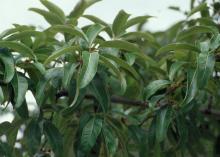Quercus imbricaria
Common name:
Shingle Oak
Pronunciation:
KWER-kus im-bri-KA-ri-a
Family:
Fagaceae
Genus:
Type:
Broadleaf
Native to (or naturalized in) Oregon:
No
- Deciduous tree, 50-60(80) ft [15-18(24) m] tall, similar or greater spread, pyramidal when young, round-topped when old. Leaves alternate, simple, oblong to lanceolate, 7-16 cm long, acute or rounded at the ends, tip may be bristle-like, margin slightly thickened and revolute (turned under), dark green and glabrous above, pale green or brownish and pubescent below; petioles 5-15 mm long; unfolding leaves in spring are reddish, the fall foliage colors are yellow-brown to russet-red, old leaves may persist through winter. Flowers small, male flowers in catkins 5-7.5 cm long, female flowers axillary on new growth, appear with the leaves. Fruit (acorn) hemispherical, 1-1.5 cm long, short stalked, enclosed 1/3 to 1/2 by a turbine-like cap, mature the second year.
- Sun. Best in moist, well-drained, rich, acid soils, but tolerates drier soils and city conditions. Reportedly easy to grow.
- Hardy to USDA Zone 4 Native range from Pennsylvania to Georgia, west to Wisconsin and eastern Kansas and Arkansas.
- imbricaria: Latin imbrex, a tile, hence overlapping in regular order like shingles, apparently after the use of the wood for shingles by early settlers in Illinois (Jacobson, 1996).
- Shingle Oak: wood used in making shingles.













